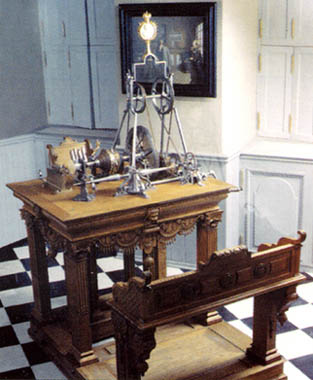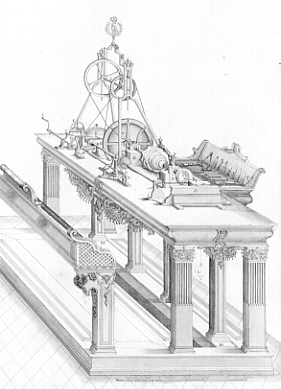
Medallic lathe of Peter the Great
1721. A.Nartov.
Reconstructed 1993, Curator V.Mokeeva,
Petropol Gallery, State Hermitage, Sestroreck's tool factory
81,4'' x 72,83'' x 50,3''
oak, metal, gilded bronze

Mould
D-14,1'', bronze
with a portrait of Peter the Great

Medal
D-4,3'', mammoth tusk
with a portrait of Peter the Great
turned on the medallic lathe

"The Personal machine of the second kind
",
fig. from the manuscript A.K.Nartov
"Teatrum Machinarum", 1755
Reconstruction history of the lathe
In 1993 our collective reconstructed the ceremonial medallic-guillocheur lathe designed and manufactured by A.K. Nartov in 1717-1721, on the personal decree of Peter the Great. The machine was destroyed during the fire in the Kunstkamera (1747). To reconstruct it, they based on the descriptions, schemes and illustrations that were found in Nartov's manuscript "Theatrum Machinarum, or a clear view of machines" (1755) stored in the manuscript sector of the Russian National Library (St. Petersburg), as well as on the analogous machines of the early eighteenth century. The creative team managed to reconstruct not only the appearance of the machine but also its power lathe. The contemporary craftsmen reconstructed the metal part of the machine with such precision that it is impossible to tell the newly turned medals from those made two centuries ago. It is on this machine that we have turned medallions with the and faces of saints and Apostles for the bone Life-Giving Cross, as well as "St. Andrew" medallions presented to Karl Gustav XVI, king of Sweden, and to Lord Hindlip, chairman of the Christie, at the Kremlin exhibition of 1996-1997. We are thankful to the State Hermitage Museum for the kind permission to take copies of Rastrelli's bronze moulds of Peter the Great's times for the completion of this work...
Valeria Mokeeva
Curator of the program
"Teatrum Machinarum"
From the catalogue of the exhibition "Rose and Cross", Moscow Kremlin, 1996-1997.
Now lathe is on a temporary storage in a museum of city of St.-Petersburg and is on display in monetary gallery St. Peter and St.Paul's cathedral. On it making medals from a wood, and in the special cases from mammoth tusk proceeds.
The medallic-copier lathe
... This is a memorial year when the Hermitage (and
not only Hermitage) celebrates the great mechanics with an extensive exhibition.
The pearl of it is the medallic-copier lathe, reconstructed by the Petropol
gallery on the basis of the sketches in Nartov's manuscript Theatrum Machinarum...
... The art of Nartov once more proved the indissoluble link between art
and science. Not only pieces of art created by Nartov due to his inventions
but also his machines fascinate you, as in them the aesthetics of Peter's
era was embodied nor less than in sculptures, paintings and buildings.
Mikhail Piotrovsky
Director
State Hermitage Museum
From the catalogue of the exhibition "Theatrum Machinarum, or the three epochs in the art of bone carving in St. Petersburg", Hermitage, Petropol Gallery, 1993.
... The main object of note at this exhibition is the
ceremonial medallic-copier lathe, reconstructed 270 years later after
it had been designed by the outstanding Russian mechanics Andrey Konstantinovich
Nartov, Peter the Great's private turner. The machine served for Peter
to turn the details of the great altar "Mammoth-Ivory Life-Giving
Cross with the Apostolic Faces on the Ark".
The exhibition presents a brilliant reconstruction of this Cross created
by the Petropol Gallery together with the Hermitage.
Irina Rodimtseva,
Director of the Moscow Kremlin Museum
From the catalogue of the exhibition "Rose and Cross", Moscow Kremlin, 1996-1997.
V.Y. Matveyev. The Hermitage, 1993.
... The concluding third sector of the jubilee exhibition
is devoted to the art of contemporary carver artists of the Petropol Gallery
(The Exhibition hall of the Petropol Gallery, Millionnaya, 27). The Gallery
unites a group of artists whose creative activity is closely connected
with St. Petersburg. Their main objectives are to study our cultural heritage,
to follow the traditions of St. Petersburg bone-carving school, to educate
young student artists, to restore old bone-carved objects, and more...
The Gallery has initiated the complex project "Theatrum Machinarum",
planned for a few years, which is aimed at the revival of "ornamental
turning" as a kind of arts. Much attention is paid by the Gallery
to the study of traditional techniques in bone-carving with the use of
copier lathes that were produced yet in Peter the Great's Turnery. On
the first stage of the implementation of "Theatrum Machinarum"
project the scientifically based reconstruction of a medallic-guillocheur
machine was performed according to the design from Nartov's manuscript.
Such an experiment was held for the first time. The reconstructed Nartov
machine is unique both by its technical parameters and by its artistic
quality. Working on the project, the participants pay tribute to the inventor
of the machine, Andrey Konstantinovich Nartov, a mechanics, designer,
researcher and artist. Thus, they have made the first step towards the
implementation of the idea to bone-carve the model of the Triumphal pillar.
This time, it is supposed to be carved and turned on the most precious
material, the fossilised mammoth tusk.
Andrey Konstantinovich Nartov opened a new stage in the development of
national technology and contributed considerably into the Russian science
and culture. He created artistic works that serve as an inexhaustible
source of inspiration for contemporary artists.
V.Y. Matveyev, Ph.D. in History of
Arts,
Vice-Director
The State Hermitage Museum
From the catalogue of the "Theatrum
Machinarum, or the three epochs of
bone-carving in St. Petersburg" exhibition. The Hermitage - Petropol
Gallery, 1993
V.I. Mokeeva, Petropol Gallery, 1993
IS THE CEREMONIAL MACHINE BY A.K. NARTOV IMAGINATIVE OR REAL?
...It is A.K. Nartov's manuscript "Theatrum Machinarum,
or a clear view of machines" that has become the source of information
for the study of "ornamental turning" techniques, lost for Russia
as far as in the nineteenth century. This manuscript contains the most
efficient information about machines for artistic processing of bones,
which could be found in Peter's Turnery.
The manuscript is important, as it was written not
by a detached observer but by a man who was deeply fond of "ornamental
turning", a practical turner and designer who made absolutely distinctive
and new machines for Peter the Great's Laboratory. In the preamble to
his manuscript, Nartov wrote: "I diligently toiled in my favourite
laboratory of turning craft, where one can find many different machines
and tools, which have never before appeared in Russia or abroad..."
As a friend and private turner of Peter's during 11 years, A.K. Nartov
was able to describe not only machinery and tools designed by himself,
but also the objects turned by him together with Peter.
For the first object of reconstruction, we selected
the personal machine (machina) of the second kind, designed for "portraying
models and historical kunshts (pieces of art)" that was designed
in perspective in Nartov's manuscript. The researchers faced up the problem
whether this machine had existed at all, for some thought that the design
of the richly decorated machine was not implemented.
Yet some facts prove that the machine had really existed.
Thus, the National storehouse of arts and crafts in Paris there is exposed
a machine designed by Nartov, though modestly decorated but quite similar
to the one represented in the manuscript. Besides, in his study, V.N.
Vassiliyev proved that the machine had been designed by Nartov, as aimed
to turn the Triumphal pillar, on a special decree of Peter the Great.
Yet in 1724 Peter examined Nartov's originally designed machines, personal
and positioned, and "found them distinctive to turn a triumphal pillar,
which he ordered to do by his decree." In her research work, N.V.
Kalyazina supposes that the ceremonial decoration on the machine could
have been performed by N. Pino, who took part in designing of the Triumphal
pillar...
... V.Y. Matveyev supposes that copies of the Triumphal pillar made of
ivory, by Peter's idea, could have been used for diplomatic gifts. Yet
the main proof of the existence of the machine, designed in the perspective,
is the reconstruction experience of the power lathe...
... All the above said puts forward a question: why does the machine from
the Hermitage have an extra function and a foot gear, which were not shown
either in the scheme or in the perspective? Another question is why the
decoration in the perspective differs strongly from that of the scheme
and the real machine. It is only history that can answer the questions.
In 1731 Nartov started the inventory of the machines that
were kept in the Turnery, but 5 December 1747 a big fire happened in the
Kunstkamera of the Academy. They were in a hurry to save the power lathes
first, taking them down out of the windows on the ropes, while the richly
decorated wooden pedestals were cut off. In 1750 Nartov, urging the reconstruction
of the lathes, which had been seriously damaged by the fire, wrote that
"without the due repair of the said machines, it was quite impossible"
to accomplish the work on the Triumphal pillar. With this, we can suppose
that he wrote about a personal machine of the second type. Yet Nartov
did not have a chance to reconstruct the machine in its original form,
for there was little money given for the reconstruction. It is most likely
that the design was made anew, with the scheme, "plan and profile'
of the machine, and on this basis a new machine was assembled, with old
and new details and constructions but without decoration. That machine
had a wider range of operations...
... The researches are still going on, but now we can say more confidently
that the machine of the second type as the one presented in the perspective
of Nartov's manuscript, really existed.
V.I. Mokeeva,
General Director,
Petropol Gallery
From the catalogue of the "Theatrum
Machinarum, or the three epochs of
bone-carving in St. Petersburg" exhibition, Hermitage - Petropol,
1993
© Valeria Mokeeva. 1993